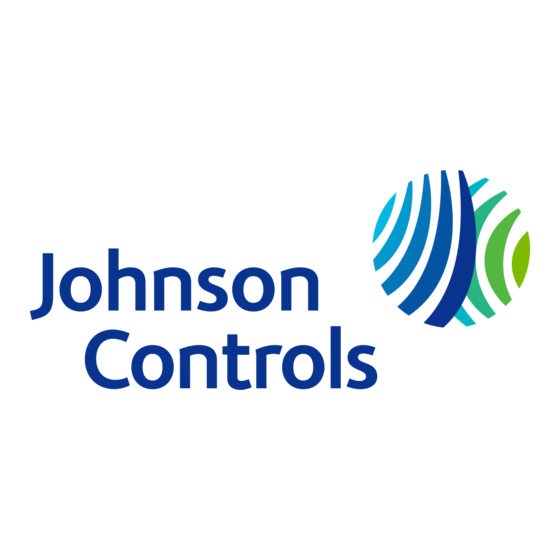Table of Contents
Advertisement
Quick Links
B501BHJ Plug-In Intelligent Sounder Detector Base
© 1995 Johnson Controls, Inc.
Code No. LIT-408020
Fire Initiating Devices and Notification Appliances Technical Manual 408
Intelligent Products Section
Technical Bulletin
Issue Date 1095
Page
3
4
7
7
7
8
11
11
12
1
Advertisement
Table of Contents

Summary of Contents for Johnson Controls METASYS B501BHJ
-
Page 1: Table Of Contents
Intelligent Products Section Technical Bulletin Issue Date 1095 B501BHJ Plug-In Intelligent Sounder Detector Base Introduction Page General Description Installation Procedures General Information Mounting Wiring Installation Guidelines Testing and Maintenance Procedures Testing Limitations © 1995 Johnson Controls, Inc. Code No. LIT-408020... - Page 2 2 Intelligent Products—B501BHJ Plug-In Intelligent Sounder Detector Base...
-
Page 3: Introduction
Failure to follow these directions may result in failure of this device to report an alarm or trouble condition or respond properly to an alarm condition. Johnson Controls is not responsible for devices that have been improperly installed, tested, or maintained by others. -
Page 4: General Description
The B501BHJ sounder base is intended for use with intelligent fire alarm General systems and provides mounting and termination for the intelligent smoke Description and heat detectors. The sounder base requires an external 24 VDC supply with reverse polarity capability. The connections for the external supply (Terminals 1 and 2) and the communication SLC (Terminals 3, 4, and 5) are isolated to prevent electrical interaction between them. - Page 5 Figure 1: Terminal Layout Note: Johnson Controls smoke detectors are marked with a compatibility identifier located as the last digit of a five digit code stamped on the back of the product. Connect detectors only to compatible control units as indicated in Johnson Controls compatibility chart, which contains a current list of UL Listed control units and detectors.
- Page 6 Table 2: Specifications Summary Specifications 1251J Ionization Detector Head Compatible Detector Heads 2251J Photoelectronic Detector Head 1551J Ionization Detector Head 2551J Photoelectronic Detector Head 2551TJ Photo Detector Head with Heat Sensor 5551J Thermal Detector Head 6.0 in. (152.4 mm) Base Diameter Base Height 2.3 in.
-
Page 7: Installation Procedures
Installation Procedures This section contains installation information for the B501BHJ sounder General detector base. Instructions are given for mounting the detector base, and Information basic wiring information is provided. Mount the B501BHJ directly to an electrical box, using the supplied Mounting mounting kit (Figure 2). -
Page 8: Wiring Installation Guidelines
Note: Do not loop the SLC or external power supply wire under the Wiring clamping plate (Figure 3). Installation Guidelines All wiring must be installed in compliance with the National Electrical Code and the local codes having jurisdiction, and must not be of such length or wire size that would cause the base to operate outside of its published specifications. - Page 9 The SLC wiring of the detector base should be checked before the detector heads are installed in them. The wiring should be checked for: continuity maximum SLC resistance maximum total cable used in the SLC polarity in the base dielectric tests The base contains a label to write the SLC, address, and type of detector to be installed at that location.
- Page 10 10 Intelligent Products—B501BHJ Plug-In Intelligent Sounder Detector Base...
-
Page 11: Testing And Maintenance Procedures
Testing and Maintenance Procedures Before testing, notify the proper authorities that the smoke detector system Testing is undergoing maintenance and will be temporarily out of service. Disable the system undergoing maintenance to prevent unwanted alarms. Detectors and bases must be tested after installation and as an integral part of periodic maintenance. -
Page 12: Limitations
Compatible smoke detectors and bases used with this accessory are Limitations designed to activate and initiate emergency action, but will do so only when used in conjunction with other compatible equipment. This detector is designed for installation in accordance with NFPA Standard 72- National Fire Alarm Code, or equivalent national codes and standards applicable to country of installation. - Page 13 Smoke detectors compatible with these bases are UL Listed to operate in specific maximum air velocities. Air velocity, along with other factors, may affect detector sensitivity. To find out the air velocities of specific detectors, see the appropriate technical bulletin. For more information, see the 1993 NFPA-72-National Fire Alarm Code, Appendix B.
- Page 14 Notes 14 Intelligent Products—B501BHJ Plug-In Intelligent Sounder Detector Base...
- Page 15 Notes Intelligent Products—B501BHJ Plug-In Intelligent Sounder Detector Base 15...
- Page 16 Notes Controls Group FAN 408 507 E. Michigan Street Fire Initiating Devices and Notification Appliances Technical Manual P.O. Box 423 Printed in U.S.A. Milwaukee, WI 53201 16 Intelligent Products—B501BHJ Plug-In Intelligent Sounder Detector Base...






Need help?
Do you have a question about the METASYS B501BHJ and is the answer not in the manual?
Questions and answers